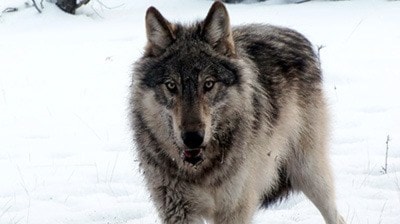British Columbia's plan to manage the population of one of its top carnivores has some conservation groups howling, while ranchers argue they need ways to protect their livestock.
The B.C. Liberal government's wolf management plan, released on April 17 following a long consultation process that saw 2,500 submissions from the public, proposes a continuation of a “two-zone management strategy” to maintain wolf populations.
According to the document, “wolves play an important role in structuring predator–prey systems, but they are also a threat to livestock, and in very rare cases, to human safety.”
In most areas, hunting seasons and bag limits control wolf harvesting opportunities, while in agricultural areas, ranchers maintain the right to eliminate problem wolves on their land year-round.
The Ministry of Forests, Lands and Natural Resource Operations states the plan is balanced and based on sound science.
However, some wildlife advocacy groups disagree, stating the plan makes it too easy to kill wolves.
In a news release, Wolf Awareness Inc. spokesperson Sadie Parr says grey wolves are “treated like vermin” in B.C.
Of the 2,575 public comments received by the ministry during the consultation process, Parr says 1,614 comments – over 60 per cent – were against the proposed plan, and urged the government to include more conservation and humane treatment of wolves.
“The government has continued to further relax hunting and trapping policies, as well as hired trappers and funded Conservation Officers in recent years to kill wolves.... In more than half of the province, hunters can now kill an unlimited number of wolves 365 days of the year.”
Parr adds the impact of wolves on the livestock industry is “grossly exaggerated.”
“The allowable use of bait, neck snares, and motorized vehicles to kill wolves is completely out of sync with any concept of fair chase.”
Marvin Monical, who owns and operates a cow-calf ranch near Lac la Hache, works with provincial conservation service operators and trappers as part of a predator conflict committee that meets in Williams Lake.
Monical says ranchers aren't out to destroy wolves willy-nilly, as some suggest.
“What the public perceives is ranchers want to kill every wolf in the province. That's not true. We just want to protect our livestock.
I, personally, have a resident wolf living in my backyard. He doesn't cause me any harm, and I don't cause him any harm.”
Monical recalls an episode about four years ago when his family lost dozens of cattle one season to a wolf pack on property near 105 Mile.
“It was a female training her pups how to kill,” he explains.
“They wouldn't necessarily eat the carcass. They would kill it and leave it.
“So we had to eliminate that pack. We disrupted it enough and it moved on.”
The rancher says he hasn't had a problem with wolves to that extent since then.
According to the government, wolf populations in the Thompson, Cariboo, Kootenay and Okanagan regions appear to be increasing while other populations appear to be stable.
The current wolf population in B.C. is estimated at between 5,300 and 11,600. In the Cariboo, wolf numbers are estimated between 550 and 1,250.
The plan also recommends improving the accuracy of provincial and regional wolf population data.
